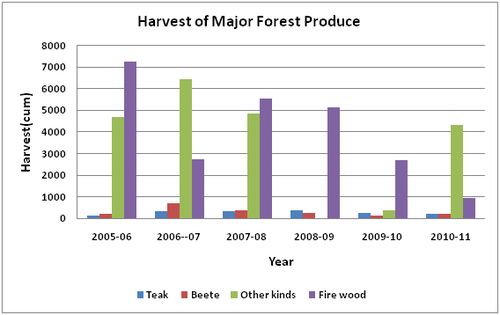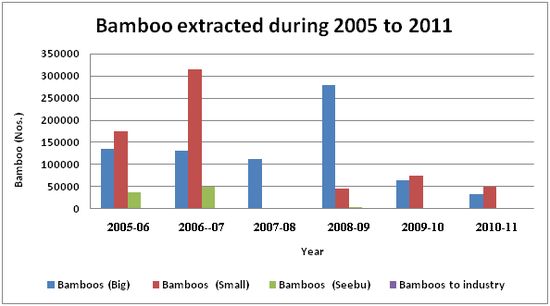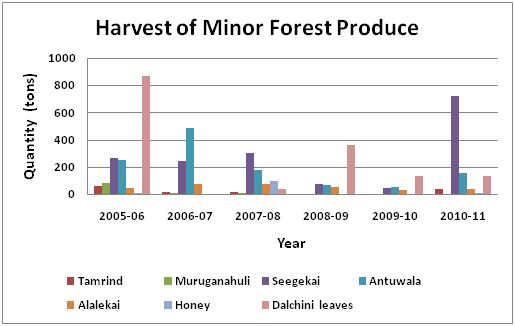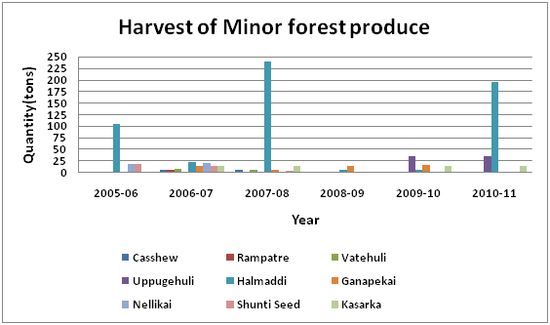Mammals: The Shimoga district is rich in fauna with varied mammals due to diverse forests of tropical evergreen, moist deciduous and dry forests.Elephants, Indian bison, antelopes, sambar, Indian tigers, panthers, leopards, barking deer, wild pigs, black monkeys, jungle cats, bears, red squirrels and porcupines are found in the high forested area of Shimoga and Sagartaluks. The wild boar, destructive to crops, is predominant in Channagiri, Nagar and other parts (working plan, 2003)
Birds: A good number of species of birds are found in the woods of Shimoga district. Among the important species are parrot, vulture, kite, green pigeon, rock pigeon, peafowl, jungle fowl, partridge, wood-pecker, myna, tailor bird, sparrow, swallow, king fisher, etc.Teals, ducks and wild geese are found in the tanks of Shimoga and Channagiritaluks. The district is also noted for game birds such as tree pie, jungle crow, gray tit, yellow-cheeked tit, parrots, peacocks, herons and storks.
Reptiles: Crocodiles are found in the Tunga and Bhadra rivers. Among the other species of reptiles are tortoise, chameleon and python found in the high forested areas. Snakes are found in large numbers in the malnad areas. Green snake, krait, cobra and viper are met with in all parts of the district.
Amphibians: Green frog, bull frog and tree frog are common among the amphibians.
Fishes: Among the fishes, the important kinds noticed in the district are black cat fish, scorpion fish, mashur and murrel fiddler.
1. FOREST WORKING PLANS
In the fast changing world of today the demand for traditional wooded products has come down considerably because of various reasons. In the 19th century and early 20th century, besides a few selected timber species, sandalwood and firewood there was not much in demand for other forest products. But by the middle of the 20th century due to rapid population growth and consequent increase in the demand several tree species and other forest products became marketable. This caused tremendous pressure on the forests and, at many places resulted in their depletion and degradation (KFD Annual report).
Timber: In the past Bhadravathi was an important source of timber supply to the market. The trees were sold after extraction, conversion, transportation and classification in the depots. From the depot timber is supplied to various departments and to bonafide users on retail sales and rest is auctioned periodically (Working Plan, Bhadravathi division). In Shimoga division, various kinds of timber from dead and fallen trees and teak poles are removed toGovernment timber depots. From the depots timber is supplied to Government departments andpublic at retail price fixed and revised from time to time. Timber left after making these supplies is auctioned periodically (Working Plan, Shimoga division).The kinds of timber in demand are Teak, Beete, Honne, Mathi, Hunal, Nandi, Surhonne, Hebbalasu, Yethyaga, Bilidevdar and Neralu. Table 10 lists the quantity of timber extracted during 1909 to 1955.
Firewood: Firewood extracted from forests is sold to public from various depots through Karnataka State Forest Industries Corporation in Bhadravathi town.There is a demand for firewood from distant places like Davanagere,Chitradurga, etc. The firewood requirement is met partly from harvest of Acacia auriculiformisplantations of the department and partly from the harvest of captive plantations of the MPM Ltd(Working Plan, Shimoga division).The MPM Ltd., as per the agreement conditions of the lease, concedes 12.5 % of the harvested produce to the Forest Department as lease rent for the land. Lops and tops of the plantations after harvest and removal of firewood and pulpwood are used by the neighbouring villagers. Figure 5 illustrates the major forest produces (teak, fuelwood, etc.) during 2005-06 to 2010-11.
Table 10: Timber operations in Shimoga district (Mysore forest administration report. 1909-1954)
| Year |
Quantity cut in forests (cft) |
| Shimoga |
Sagar |
Bhadravathi |
Total |
| 1909-10 |
|
|
|
1,91,500 |
| 1910-11 |
|
|
|
1,62,272 |
| 1911-12 |
|
|
|
1,86,574 |
| 1912-13 |
|
|
|
1,55,767 |
| 1923-24 |
3,83,033 |
84,756 |
2,99,083 |
7,66,872 |
| 1924-25 |
3,16,142 |
82,780 |
1,69,404 |
5,68,326 |
| 1926-27 |
1,81,163 |
79,877 |
3,88,973 |
6,50,013 |
| 1927-28 |
2,38,567 |
93,211 |
2,96,791 |
6,28,569 |
| 1928-29 |
2,63,134 |
61,869 |
2,45,051 |
5,70,054 |
| 1936-37 |
2,01,492 |
38,384 |
2,47,324 |
4,87,200 |
| 1949-50 |
1,06,445 |
52,999 |
1,44,602 |
3,04,046 |
| 1954-55 |
1,91,847 |
1,21,960 |
2,61,768 |
5,75,575 |
Bamboo: The dead and dry bamboos were removed for the supply to Mysore Paper Mills Ltd. Green big and small bamboos are supplied to local Medars and for bonafide users from various depots.In order to meet requirement of local people and others, greenbamboo is removed as per silvicultural principles. Figure 6 depicts the quantum of bamboo extracted during 2005-06 during 2010-11.
Sandalwood: Dead and fallen sandalwood trees are extracted from forests, departmentally and supplied to government sandalwood depot. Supplies to various agencies are made from the sandalwood depot. Table 11 provides the details of sandalwood collected from Shimoga during 1909 to 1925.
Table 11: Sandalwood from Shimoga district (Mysore forest administration report-1909-1954)
| Year |
Quantity of rough wood collected (tons) |
| Shimoga |
Sagar |
Bhadravathi |
Total |
| 1909-10 |
|
|
|
665 |
| 1910-11 |
|
|
|
766 |
| 1911-12 |
|
|
|
1213 |
| 1912-13 |
|
|
|
777 |
| 1921-22 |
105 |
27 |
|
132 |
| 1922-23 |
224 |
58 |
|
282 |
| 1923-24 |
222 |
71 |
107 |
400 |
| 1924-25 |
265 |
238 |
506 |
1009 |
| 1926-27 |
347 |
206 |
218 |
771 |
| 1927-28 |
381 |
218 |
263 |
862 |
| 1928-29 |
362 |
169 |
340 |
871 |
Bamboo and sandalwood extracted from forests during the last decade is given in Table 12.
Table 12: Bamboo and Sandalwood extracted from Shimoga district (KFD Annual report)
| Year |
Bamboo (tons) |
Sandalwood (kg) |
| 2000-01 |
995.3 |
10.211 |
| 2001-02 |
552.330 |
110.807 |
| 2002-03 |
6039.04 |
- |
| 2003-04 |
0 |
2498 |
| 2005-06 |
11605.23 (cum) |
38407 |
| 2006-07 |
1527.79 (cum) |
189 |
| 2008-09 |
170421 (nos) |
309.5 |
| 2009-10 |
150067.3 (cum) |
0.00 |
Minor forest products
Non-timber forest products are important forest products. In Karnataka, forests play animportant role in the socio-economic development of the state. Forests help in maintaining a stable environment conducive to sustained development of agriculture. Forests meet a large share of the energy needs of the population, more so in the rural areas. A significant portion of the fodder needs of the vast cattle population is also met from the forest. Forest products, in addition to contributing to the state’s income, also play a very important role in the rural and tribal economy. Many of the forest products, including non-timber forest products (NTFPs), provide sustenance to the rural and tribal people, who collect a large part of their dailynecessities, including food and medicines, from the forests. Most of these products represent a direct subsidy to the rural poor, and constitute an integral element of the factors alleviating their poverty. For landless and marginal farmers living in the vicinity of forests, forest-related activities generate their primary source of income. (Panchamukhi et.al)
In Karnataka, collection of non-timber forest produce is being entrusted mainly to Tribal Societies. There are 19 such Tribal Societies in Karnataka. Wherever the societies do not exist the NTFP collection leases are granted through tender-cum-auction sales. Firewood is sold at fixed rates at the depots for domestic consumption. Canes and bamboos are provided by the department on payment basis against the quantity allotted to private artisans (Govt of Karnataka, 1996). These officially extracted NTFPs are included in the estimation of the state domestic product. The value of NTFPs collected by the local populationis not included in the estimation of SDP. Failure to take these resources into account means neglecting a considerable source of wealth, at least locally. This also prevents optimal resource allocation.
Forests of Shimoga produce a variety of products such as leaves, fruits and flowers that are used locally or traded. The common minor forest produces are soapnut, tamarind fruits, tanning barks, honeybee wax, seeds, non-edible oil seeds, etc. These productsare of great economic value, and are known as Minor Forest Produce (MFP). This also includes different varieties of medicinal plants which are highly valuable. Due to over exploitation and unscientific way of harvesting, some medicinal plants have become extinct. For better regeneration, protection and management of these resources, these products should be harvested in controlled and scientific manner. Figure 7.1 and 7.2 provides the quantity of MFP during 2005-06 to 2010-11.
Present method of Harvesting
At present,Minor forest products are sold through tender-cum-auction sale once in two years taking range as a unit. Since there is no proper knowledge available for collection of products, contractors use very crude methods for collection of MFP. This results in large-scale destruction of the resource base. There is no regulation by the Department (KFD) on the intensity of collection of MFP. The payment to the workers is based on quantity of produce collected. So the workers(unskilled, skilled) extract maximum quantity within short time.
The evergreen forests yield timber which was used for electric transmission poles and railway sleepers. The felled areas are being tended for getting the natural regeneration of valuable species. The deciduous forests supply timber, firewood, charcoal, bamboos, matchwood and plywood. Plantations of teak, silver oak (Gravillearobusta), matchwood and other valuable species are raised in the clear-felled areas for improving the potential of the forests and for meeting the demand for certain species (ShimogaGazeteer, 1975). Dry deciduous forests are useful for firewood and charcoal. Suitable areas in the district are afforested with eucalyptus and other forest growing species under various plan schemes. Dry scrub Forests are afforested as a measure of soil conservation under relief works such as drought relief, famine relief and rural employment programme. The Mysore forest department had a commitment of supplying 36000 tons of firewood per year to Mysore Iron and Steel, and 50000 tons of air dry bamboo to Mysore Paper mills(Mysore forest administration report). Table 13 provides the timber and major forest produce in Shimoga circle during the last decade.
Table 13: Timber and Major Forest Produce (Shimoga circle) (KFD Annual report)
| Year |
Rosewood (cum) |
Teakwood (cum) |
Sawn Timber (cum) |
Other kinds of timber (cum) |
Nilgiri (cum) |
Match wood (cum) |
Timber in round poles (cum) |
Firewood (cum) |
Softwood |
| 2009-10 |
853.76 |
935.01 |
1239.98 |
2649.43 |
146.18 |
|
900.5 |
1267.36 |
0.00 |
| 2008-09 |
227.661 |
240.738 |
3933.47 |
3541.66 |
19.44 |
|
8763.66 |
1791.88 |
0.00 |
| 2006-07 |
236.170 |
150.740 |
36.630 |
2805.85 |
383.11 |
|
4158.00 |
2529.76 |
0.00 |
| 2005-06 |
146.27 |
84.19 |
28.4 |
1598.6 |
284.32 |
|
475.69 |
909.81 |
0.00 |
| 2003-04 |
122.19 |
140.72 |
41.05 |
1119.34 |
12.85 |
0.00 |
320.95 |
1740.42 |
808.00 |
| 2002-03 |
158.949 |
105.770 |
36.355 |
437.522 |
85 |
- |
17.633 |
5369.528 |
2238.054 |
| 2001-02 |
337.97 |
157.658 |
53.803 |
1563.45 |
1.958 |
- |
78 597 |
13,475.357 |
128.867 |
| 2000-01 |
201.743 |
149.311 |
43.213 |
1263.96 |
584.17 |
.830 |
2,925.31 |
11,585.1 |
20.368 |

Figure 5: Major forest produces in Shimoga circle from 2005-2006 to 2011-2011

Figure 6: Bamboo extracted in Shimoga circle during 2005-2006 to 2010-2011

Figure 7.1: Minor Forest Produce in Shimoga circle during 2005-2006 to 2010-2011

Figure 7.2: Minor Forest Produces in Shimoga circle during 2005-2006 to 2010-2011
2. FOREST ALLOTMENT FOR NON-FORESTRY PURPOSES
Hydroelectric and irrigation Projects (River valley projects)
There are, 4 irrigation projects (Tunga, Ambligola and Anjanapur and Jampadahalla projects), irrigation and power (Bhadra reservoir) and one power (The Sharavathi Valley Hydroelectric Project) project in the district. The very well wooded area submerged in these development projects are given below:(Working Plan, 1962).
| Sharavathi valley Hydroelectric Project-318.57 sq.km |
| Bhadra Reservoir Project-112.66 sq.km |
| Tunga Reservoir Project-13.31 Sq.km |
| Ambligola Reservoir-4.35 Sq.km |
| Jampadahalla Reservoir-1.6 Sq.km |
These projects have a serious bearing on the forest percentage, forest management and yields from the forests. Before these river valley projects were taken up, the hill districts of Shimogahad a forest percentage of 23.8 andover 90% constituted dense wood land with growing stock upto 5000 c. ft. and more per acre (360m3/ha) (Working Plan,1962).
In addition to the permanent loss of forest land by submersion, the water spread disrupts and destroys land communications to other valuable forests, making them useless pockets. The area submerged under Sharavathi project is largely of the semi evergreen type. The areas submerged under Bhadra, Tunga, Ambligola and Jampadahalla reservoirs include the finest natural teak bearing areas (Working Plan, 1962).The big reservoirs bring about changes in the surrounding areas and even in composition of nearly forest, making them moister. Table 14 details the extent of forest area released for non-forestry purposes in Shimoga circle and Table 15 provided the details for the period 2008 to 2011.
Table14: Forest area released for non forest purposes(since formation of divisions to 2007-08) in Shimoga circle
| Sl. No. |
Circle |
Division |
Range |
Location (Sy. No) |
Extent of Area in Ha |
G.O.No.& Date |
Project / Purposes |
Remarks |
| Bhadravathi Division |
|
|
|
| 1 |
Shimoga |
Bhadravathi |
Bhadravathi |
BullapuraSy. No. 55 |
215.220 |
No. C1 192 11W 50 Dt. Bangalore |
For VISL township |
|
| |
|
|
|
Anekoppa Sy.No.44 |
147.210 |
25/26-9-1959 &FFD FGL 73, Bangalore |
|
|
| |
|
|
|
Ujjanipura Sy.No.05 |
34.230 |
11/2/1980 |
|
|
| |
|
|
Tarikere |
Kemmanagundi |
80.000 |
AHFF 83 FTM 90 dt.23-4-91 |
For removal Iron ore. |
Land leased period expired ( Area handed over to Bhadra wild life Division) |
| |
|
|
Bhadravathi |
Siddarahalli&Chammanahalli |
860.000 |
MC 624/30-7-68 |
manganese ore. |
Proposal rejected in higher authorities |
| |
|
|
Umblebyle |
Bilikalbetta |
81.340 |
ML 1910/27-9-83 |
Granite stone |
Not in Operation |
| |
|
|
Channagiri |
Bandigudda |
40.120 |
ML 1966/28-2-85 |
Lime stone |
Mining lease renewed by MOEF. |
| |
|
|
Bhadravathi |
Antharagange SF & MF |
47.600 |
GO 1850-95-FC dt.15-5-1996 |
Agriculture purpose |
Prior to 1978 encroachment yet to be released process is going on. |
| |
|
|
Umblebyle |
Umblebyle SF &Hunsekatte MF |
11.980 |
- |
- |
- |
| |
|
|
Channagiri |
Basapura SF Laxmipur MF, Kaggi MF. |
106.840 |
- |
- |
- |
| |
|
|
Nallur |
Bhadrapura SF |
78.690 |
- |
- |
- |
| |
|
|
Lakkavalli |
Gurupura, Kundur&Tyagadabagi MF |
17.570 |
- |
- |
- |
| |
|
|
Umblebyle |
Halalakkavalli No 19 |
223.900 |
No.8-30-97-FC dt : 1-10-03 |
Project Purposes |
Hon'ble supreme court central Govt. agrees in Principal for division |
| |
|
|
|
Chornadihalli 37,45 |
|
|
|
|
| |
|
|
Total |
|
1944.700 |
|
|
|
| Shimoga Division |
|
|
|
|
| |
Shimoga |
Shimoga |
Ayanur |
Kumsi |
526.100 |
Agreement on dated:30-7-69 |
Mining |
Renewal proposal has been submitted to government. |
| |
|
|
G.T.D. Alkola |
Sy.No.1 of SrigandaKavalu |
1.210 |
FEE 59 FGK 93 05-07-1994 |
Ring Road Project |
|
| |
|
|
Shankar Range |
Sy. No.1,2 |
22.260 |
FEE 89 FGL/94 dt: 13-1-05 |
Upper Tunga Project |
|
| |
|
|
Mandagadde Range |
Sy No. 14,18,40,41, 55 & 56 |
143.230 |
|
| |
|
|
Total |
|
692.800 |
|
|
|
| Sagar Division |
|
|
|
|
| |
|
Sagar |
Nagara KPC |
Varahi Project |
2668.000 |
- |
Project |
|
| |
|
Chakra --,,-- |
1325.000 |
- |
--,,-- |
|
| |
|
Savehaklu --,,-- |
853.000 |
- |
--,,-- |
|
| |
KPTCL |
Kararibylu to M.K. Byle road |
600.000 |
- |
Projected (Road) |
|
| |
KPC |
ChannalCutting |
400.000 |
|
Channal |
|
| |
KPC |
Under submerssion |
24460.000 |
-- |
|
|
| |
Hosanagar |
Under submerssion |
7760.000 |
|
Submerssion |
|
| |
Sagar |
Under submerssion |
8840.000 |
|
Submerssion |
|
| |
KPTCL |
Sagar to Sorab 110 K.V. Line |
39.000 |
FEE 106 FGL-941 Dtd: 7-11-1995 |
Submerssion construction of 110 K.W. line |
|
| |
Shikaripura |
Under submerssion |
743.000 |
- |
Submerssion |
|
| |
Soraba |
--Nil-- |
--Nil-- |
-- |
|
|
| |
KPC Kargal |
Under submerssion |
51.150 |
G.O.No. 53, FGL. 2000 Hydro Electro Project at 6-10-2000 |
|
|
| |
|
220 K.V. Line From S.T.R.P.T.O. Talaguppa |
20.600 |
|
|
|
| |
Shikaripura |
Hosur Mines |
17.500 |
G.O.No. FEE.78.FFM. 96. Dt 12-11-2001 |
|
|
|
Kargal |
TalakalaleSy.No. 118, 151 |
7.100 |
FEE-253-FGL/2000/13-5-2002 |
Mahatma Gandhi Hydro electric tail race |
|
|
Chordi |
KonehosurSy.No. 47 &GilalgundiSy.No. 4 |
3.200 |
FEE-297-FGL/298/03/26-3-2003 |
KollibachalluHalla |
|
| |
Anavatti |
Construction of first grade collage in Sy. No. 10 of Anavatti |
1.600 |
FEE-321-FGL-2000 dated : 19-10-01 |
Construction of first grade collage |
|
| Total |
47789.15 |
|
|
|
| Wildlife Division Shimoga |
|
|
| 1 |
Shimoga |
Wildlife |
Sacrebyle |
Shettihalli wildlife sanctuary |
49.260 |
FEE-89-FGL-1994 dated : 13-01-06 |
For Construction of Upper Tunga Project |
Released on 30-3-06 |
| S. F. Division Shimoga |
|
|
|
| 1 |
Shimoga |
S.F.Dn |
|
Nil |
- |
- |
|
|
| |
|
|
Circle Total |
|
50426.65 |
|
|
|
Table 15: Forest area released for non forestry purpose from 2008-2011
| Division |
Area in Hectares |
| 2008-09 |
2009-10 |
2010-11 |
| Bhadravathi |
709.12 |
317.34 |
389.867 |
| Sagar |
9.401 |
0 |
|
| Shimoga |
3351.32 |
3351.32 |
7.374 |
| Shimoga wildlife |
0 |
0 |
|
| Total |
4069.844 |
3668.66 |
397.241 |
4. PLANTATIONS
Some of the areas of forest divisions are leased out to 1) Mysore Paper Mills (MPM) limited, 2) Karnataka Forest Development Corporation (KFDC) limited and 3) Karnataka Cashew Development Corporation (KCDC). Divisionwise extent of plantations for the period 2005 to 2011 is given in Table 16.
Table 16: Plantations raisedduring 2005-2010 in Shimoga circle
| Division |
Plantation extent in hectares |
| 2005-06 |
2006-07 |
2007-08 |
2008-09 |
2009-10 |
2010-11 |
| Wildlife Division Shimoga. |
0 |
277.5 |
250 |
10 |
0 |
45.00 |
| Bhadravathi |
734.50 |
1018 |
2240 |
2918 |
2375.00 |
2375.00 |
| Social Forestry Shimoga |
359.50 |
241 |
14 |
96.5 |
117.90 |
10.00 |
| Shimoga Division |
1267.50 |
1092 |
1930.87 |
1980.12 |
2699.00 |
2845.00 |
| Sagar Division |
949.00 |
1319.24 |
3080.00 |
2872 |
1825.00 |
1445.00 |
| Circle total |
2576.00 |
3947.740 |
7514.870 |
7876.62 |
7016.9 |
6720 |
REFERENCE
- Aralikatti,K.S. (2001).Working plan for the forests of Shimoga division.
- Forest Survey of India (Ministry of Environment and Forests), Government of India. India State of Forest Report 2011.
- Karnataka Forest Department Annual Report for the Year 1990-2010.
- Karnataka forest department Annual Report 2009-10.
- Karnataka state Gazeteer department, Shimoga Gazetter-1975.
- Panchamukhi.P.R, PushpaTrivedi, Saibala Debi, Arun Kumar Kulkarni and Preeti Sharma. Natural Resource Accounting in Karnataka A study of the land forestry sector.
- Report of the Forest Administration in the Mysore state for the Years 1893-1956
- Rangaswamy,V.( 2003).Working plan for the forests of Bhadravathi division.
- Rangaswamy,V.( 2003).Working plan for the forests of Sagar division.
- Working plan report for supply of firewood and charcoal to Mysore Iron and steel limited,Bhadravathi and Bamboos to Mysore paper mills limited, Bhadravathi from forests of Bhadravathi, Tarikere, Chikmaglur,Shimoga and Sagar division-July 1962.





